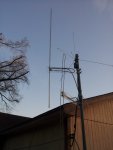Guys - reality check time ...
Back in the 80's when Bill Cheek and I were goofing on this antenna, it was a junkbox hack, not a serious antenna. See the older rec.radio.scanner usenet archives...
It was meant to be just a simple replacement for the typical 19" whip that came with a scanner, and then promptly thrown into the corner of the room. Or perhaps snuck outside with only about 15 feet of coax.
Like the popularity of the "non resonant verticals" in the HF world with only a 4:1 unun at the feedpoint, there are serious issues to deal with - and as long as you understand those issues, you will be happy as long as it meets your needs. (amateurs might be familiar with the canonical 43-foot vertical having a bad radiation angle above about 15m, and below 40m on 80 and certainly 160, reactive components are so lossy that it is a joke to use a 43-footer on those bands.) Same kind of issues here.
So don't go bananas over swr measurements - it will vary a lot depending on the build - each one will be different, and also the fact that the system is unbalanced (un unchoked usually), as well as the inability to measure swr from the feedpoint with an odd half-wave of coax for all frequencies of interest!
Even then, if you get the swr right, have you checked the overall loss of the transmission line with the swr - ie, 50 feet of RG-58 with a 3.5:1 swr at 800 mhz? Can you say system loss? Along with a poor radiation angle at 800 mhz pointing almost straight up?
So just a warning that needs repeating once in awhile - these are fun "starter" antennas, but they are not meant to be taken very seriously. Only enough for the owner to have some fun in between replacing the 19" telescopic whip with a really well designed antenna.
In other words, I would think it totally insane to "improve" the ocfd antenna system with heliax as your feedline - even though technically, yes, that would be a good thing to do. At some point things become a bit ridiculous.



